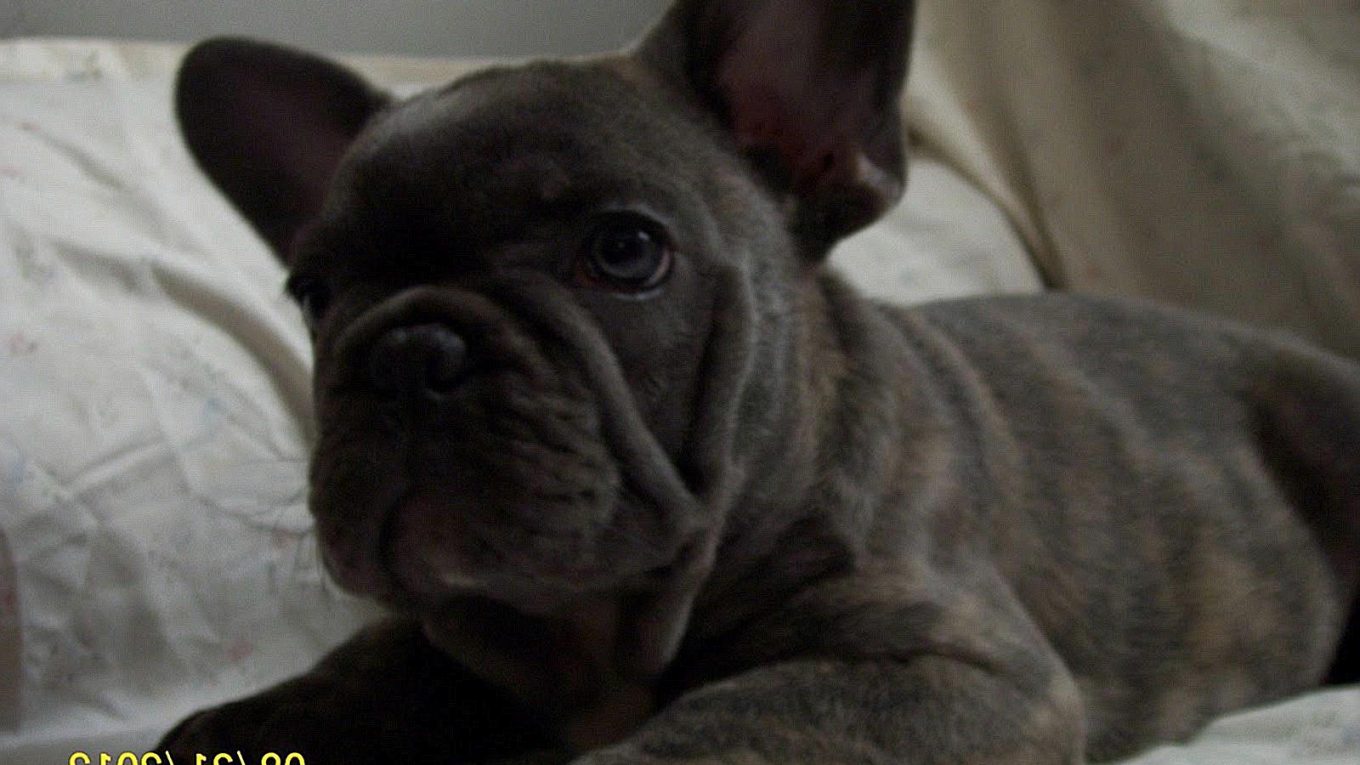How do you introduce a Frenchie to a baby?
Title: “Bonjour Bébé. Bringing French Bulldogs and Babies Together”
Introduction:
Contents
- 1 Preparing Your Frenchie for the Baby’s Arrival
- 2 Creating a Calm and Controlled Environment for the Initial Meeting
- 3 Allowing Supervised Interactions between the Frenchie and the Baby
- 4 Setting Boundaries and Expectations for Behavior
- 5 Understanding Frenchies’ Sensitivity towards Babies
- 6 Tips for Keeping Both Parties Safe During Introductions
- 7 How to Respond if Your Frenchie Shows Signs of Stress or Discomfort
- 8 Teaching Your Child How to Interact with the Dog
- 9 Conclusion
Adding a new member to the family is always an exciting time, but when you have a French Bulldog and a baby in the mix, get ready for double the fun. French Bulldogs, or as we affectionately call them, “Frenchie,” are known for their playful nature and loving personalities. They make wonderful companions for little ones. Whether you’re a proud Frenchie parent introducing your fur baby to a newborn or thinking about adopting a pup with a toddler at home, this article is here to help you navigate the process with some French flair.
So, let’s dive in and discover how to introduce a Frenchie to your baby, creating an unbreakable bond that will warm your heart and create memories that last forever.
Preparing Your Frenchie for the Baby’s Arrival
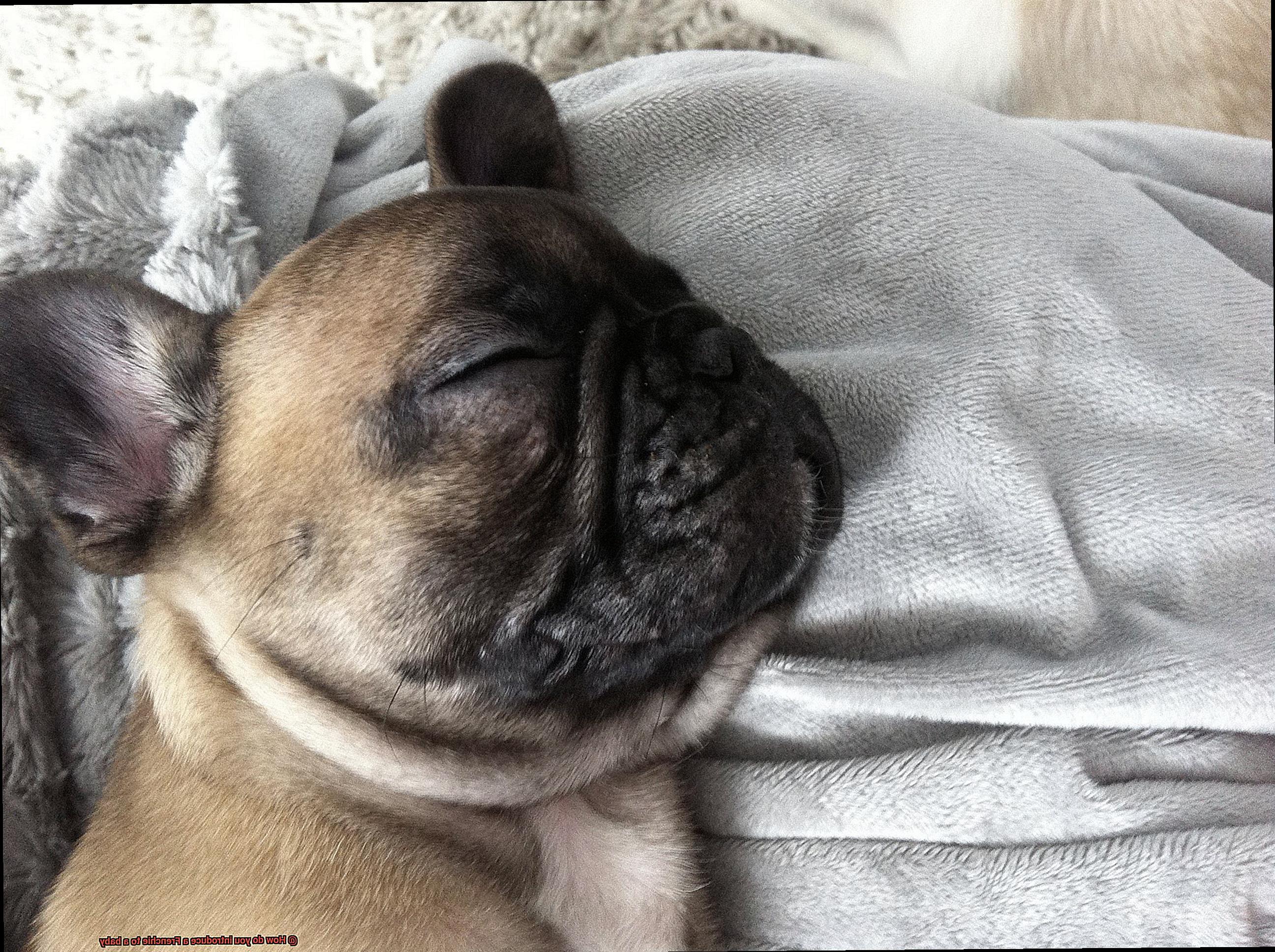
Congratulations on your growing family. As you eagerly await the arrival of your new baby, it’s essential to prepare your French Bulldog for this exciting change. Frenchies are known for their loving and loyal nature, but it’s important to take some steps to ensure a smooth transition for both your pet and your baby. In this comprehensive guide, we’ll provide you with expert tips and strategies to prepare your Frenchie for the baby’s arrival.
- Establish a Routine: Dogs thrive on routine and structure, so it’s crucial to establish a consistent schedule for your Frenchie before the baby arrives. Set regular feeding times, exercise routines, and play sessions. By maintaining a routine, your Frenchie will feel more secure and less anxious when the baby comes home.
- Desensitize to Baby Sounds: Babies can be noisy with their cries, coos, and laughter. To help your Frenchie become accustomed to these sounds, gradually introduce recordings of baby noises in the weeks leading up to the baby’s arrival. Start with low volume and gradually increase it over time. Reward your Frenchie with treats or praise when they remain calm during these sessions.
- Familiarize with Baby Gear: Babies come with a lot of gear like strollers, cribs, and car seats. It’s essential to let your Frenchie explore and sniff these new items before the baby arrives. Allow them to get used to the presence of these objects so that they don’t become stressed or anxious when they see them with the baby.
- Set Boundaries: Establish boundaries for your Frenchie before the baby arrives. Decide which areas of the house will be off-limits once the baby is born, such as the nursery or certain furniture pieces. Train your Frenchie to respect these boundaries using positive reinforcement techniques like treats, praise, and redirection.
- Gradual Introduction to Baby’s Scent: Babies have a distinct scent that can be unfamiliar to your Frenchie. To help them adjust, bring home an item of clothing or a blanket that carries the baby’s scent before they come home. Allow your Frenchie to sniff and investigate this item under supervision. This gradual introduction will help them become familiar with the baby’s scent and reduce any potential anxiety when they finally meet face to face.
- Socialization: It’s essential to continue socializing your Frenchie with other people and animals during your pregnancy. This will help them maintain their social skills and reduce any potential jealousy or possessiveness when the baby arrives. Enroll in obedience classes or playdates with other dogs to ensure your Frenchie remains well-adjusted and friendly.
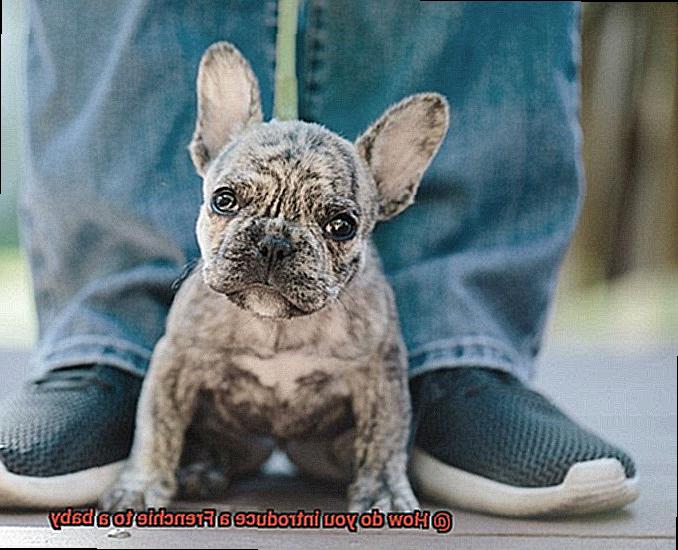
Creating a Calm and Controlled Environment for the Initial Meeting
You’ve got a new addition to your family – a beautiful baby. Now, it’s time to introduce your French Bulldog to your little bundle of joy. But before you jump into this exciting moment, it’s crucial to create a calm and controlled environment for their initial meeting. Here’s why it matters:
Safety First:
The safety and comfort of both your Frenchie and your baby are of utmost importance. By creating a calm and controlled environment, you can minimize potential risks and ensure a positive experience for everyone involved.
Prepare the Space:
Before the introduction, remove any potential hazards or distractions from the area. Baby toys that may provoke your Frenchie’s curiosity should be kept out of reach, and items that could be harmful if chewed on should be stored away. A clean and clutter-free space will help reduce anxiety and overstimulation for both your furry friend and your baby.
Neutral Territory:
To avoid possessiveness or protectiveness from your Frenchie, introduce them to the baby in a neutral space. This can be a separate room or an outdoor area that neither of them is familiar with. By doing so, you’ll ensure a more balanced interaction free from territorial behavior.
Exercise and Mental Stimulation:
A tired dog is a calm dog. Before the meeting, make sure your Frenchie gets plenty of exercise and mental stimulation. Taking them for a walk or engaging in playtime can help release excess energy, promoting a more positive interaction with the baby.
Calm Demeanor:
Remember, dogs are highly perceptive of human emotions. When bringing the baby into the space, remain calm and confident. Your Frenchie will sense any anxiety or nervousness you might have, so displaying a calm demeanor will reassure both your furry friend and your baby that everything is under control.
Supervision and Assistance:
Having another adult present during the initial meeting is crucial for supervision and assistance. This ensures that both your Frenchie and your baby are closely monitored, and any potential issues can be addressed promptly. An extra set of hands also helps create a safer environment for their introduction.
Gradual Introductions:
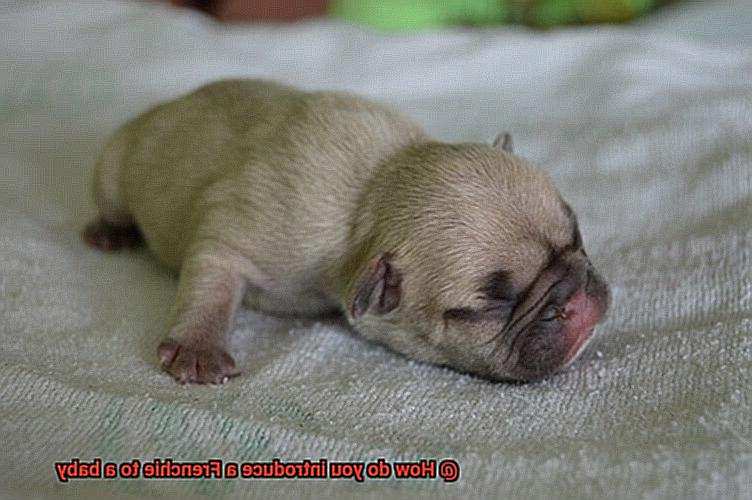
Start by allowing your Frenchie to sniff the baby from a safe distance. You can hold the baby in your arms or have them securely placed in a bassinet or carrier. Your Frenchie’s natural curiosity will lead them to investigate this new family member.
Watch for Body Language:
Pay close attention to both your Frenchie and your baby’s body language during this initial interaction. Look for signs of discomfort, anxiety, or aggression in your dog, such as growling, barking, or stiff body posture. Similarly, observe your baby’s reactions, such as crying or flinching, which may indicate fear or discomfort.
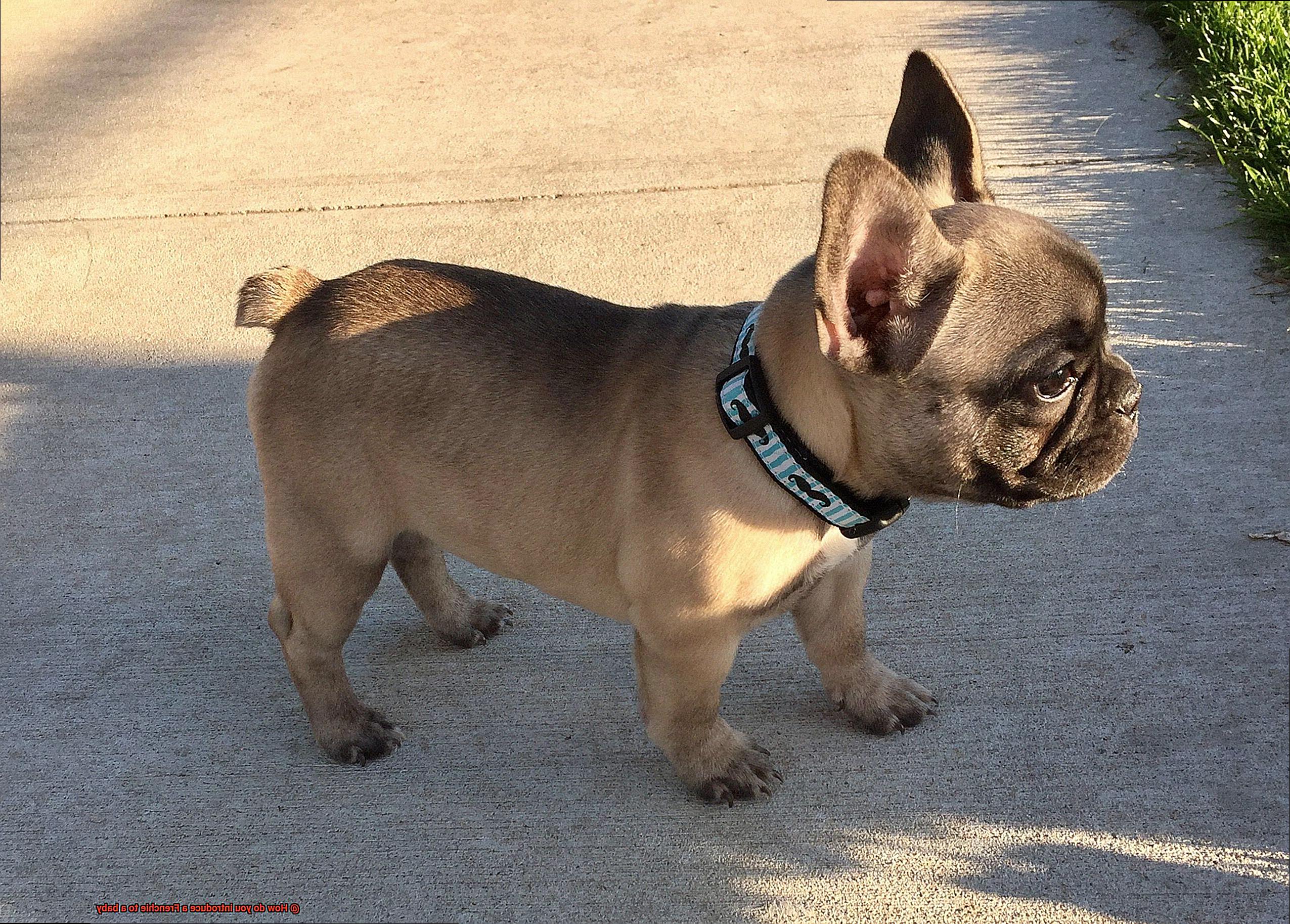
Allowing Supervised Interactions between the Frenchie and the Baby
Introducing a Frenchie to a baby can be an exciting and nerve-wracking experience. Ensuring a safe and positive interaction is crucial for building a strong bond between the two. In this blog post, we will explore the importance of gradually introducing a Frenchie to a baby and providing positive reinforcement during supervised interactions.
Supervision is Key:
The safety of both the Frenchie and the baby should never be compromised. Having someone present to supervise their interactions is vital. This allows for immediate intervention if any issues arise, ensuring a safe environment for both.
Gradual Introduction:
Starting with a gradual introduction sets the foundation for a successful relationship. Allowing the Frenchie and the baby to observe each other from a distance helps them become familiar with each other’s presence without direct contact. The baby can be in a playpen or crib while the Frenchie roams freely in the same room, creating a sense of curiosity and interest.
Positive Reinforcement:
Rewarding calm and positive behavior during supervised interactions is essential. Treats and praise can be given when both parties exhibit appropriate behavior, such as staying calm, showing curiosity without aggression, or gentle interactions. This positive reinforcement reinforces good behavior and strengthens the bond between the Frenchie and the baby.

Controlled Physical Contact:
As comfort levels increase, controlled physical contact can be introduced. Allowing the Frenchie to sniff or lick the baby’s feet or hands under close supervision helps them become more familiar with each other’s scent and presence. It is important to ensure that both parties are comfortable with these interactions and show no signs of fear or discomfort.
Teaching Boundaries:
Establishing boundaries is crucial for a respectful relationship between the Frenchie and the baby. Teaching the Frenchie not to jump on or invade the baby’s personal space, and teaching the baby not to pull on or harass the Frenchie, helps create a harmonious environment. Consistency in enforcing these boundaries is key to their success.
Time and Patience:
Remember, Rome wasn’t built in a day. Introducing a Frenchie to a baby requires time and patience. Each dog and baby is unique, and they may need different amounts of time to feel comfortable around each other. By allowing for a gradual introduction and providing positive experiences, the bond between the Frenchie and the baby can grow stronger over time.
Setting Boundaries and Expectations for Behavior
Setting Boundaries and Expectations for Behavior: Creating a Harmonious Relationship Between Your French Bulldog and Baby
Introduction:
Introducing your French Bulldog to your baby can be an exciting and nerve-wracking experience. To ensure a safe and harmonious relationship between them, it is crucial to set clear boundaries and expectations for behavior. In this blog post, we will explore the key steps and insights to help you establish a loving and respectful bond between your Frenchie and your baby.
Step 1: Training for Appropriate Behavior
Teaching your Frenchie appropriate behavior around the baby is essential. Consistent training and positive reinforcement can help prevent any accidental mishaps. Start by teaching your dog basic commands such as sit or stay when in close proximity to the baby. This will promote a calm and controlled environment.
Step 2: Respecting Personal Space
Establishing rules regarding personal space is vital. Teach your Frenchie to respect the baby’s personal space and not invade it without permission. Encourage your dog to stay at a safe distance from the baby when necessary, preventing potential accidents or discomfort.
Step 3: Food Boundaries
Babies are naturally curious and may try to grab or play with the Frenchie’s food. Establishing a designated eating area for your dog away from the baby can help avoid conflicts or food-related issues. This ensures both the baby’s safety and the dog’s mealtime enjoyment.
Step 4: Appropriate Playtime
French Bulldogs are known for their playful nature, but it’s important to teach them appropriate play behavior around the baby. Discourage rough play or jumping on the baby, creating a safe and enjoyable environment for both parties. Engage in supervised play sessions that are gentle and controlled.
Step 5: Consistency is Key
Consistency is crucial when setting boundaries and expectations for behavior. Enforce these rules consistently and reinforce positive behavior through rewards and praise.
This will help your Frenchie understand what is expected of them and create a harmonious relationship with the baby.
Understanding Frenchies’ Sensitivity towards Babies
French Bulldogs, or Frenchies, are known for their affectionate and friendly nature. However, it is important to understand their sensitivity towards babies in order to ensure a smooth and safe introduction.

Frenchies have a strong bond with their owners and may become protective of them, especially when a new addition, such as a baby, comes into the family. This protective nature can manifest in various ways, such as increased vigilance or even jealousy.
Gauging Your Frenchie’s Reaction
Before introducing your Frenchie to your baby, it is crucial to observe how they behave around other children or infants. This can give you insights into their comfort level and help determine the best approach.
Some Frenchies may show signs of anxiety or stress when a baby is present, such as pacing, panting excessively, or avoiding the baby altogether. These signs should not be ignored and should be addressed promptly to prevent any potential issues.
Preparing Your Frenchie for the Arrival of a Baby
Proper socialization plays a key role in preparing your Frenchie for the arrival of a baby. Expose them to various stimuli associated with infants, such as the sounds and smells of baby products. This will help desensitize them and reduce any anxiety they may feel.
Introducing Your Frenchie to Your Baby
When it comes to introducing your Frenchie to your baby, gradual and controlled introductions are essential. Start by allowing your Frenchie to sniff and investigate the baby’s belongings, such as blankets or toys. This will familiarize them with the baby’s scent before bringing them closer to the baby.
Supervision and Positive Reinforcement
During the initial interactions between your Frenchie and your baby, supervision is crucial. This ensures that any unwanted behavior from either party can be addressed immediately and prevents any accidental harm. Additionally, using positive reinforcement techniques can help create a positive association in your Frenchie’s mind. Reward them for calm and gentle behavior around the baby to reinforce positive experiences.
Setting Boundaries and Training
It is important to set boundaries and establish rules for your Frenchie’s interaction with your baby. This can include not allowing the dog to jump on or lick the baby, as well as teaching your Frenchie to respect the baby’s personal space. Regular training sessions and obedience exercises can help reinforce these boundaries and expectations.
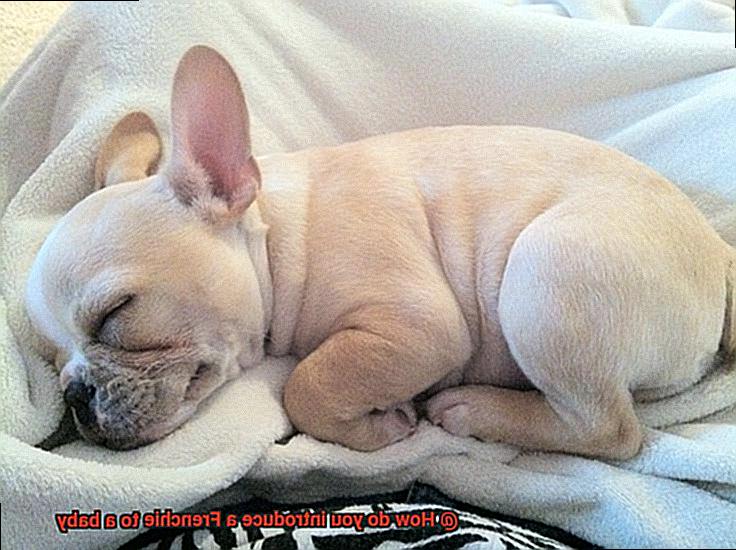
Every Frenchie is Unique
It is important to remember that every Frenchie is unique, and their reactions towards babies may vary. Some Frenchies may naturally be more accepting and gentle, while others may require more time and training to adjust. Be attentive to their individual needs and provide them with the necessary support during this transitional period.
Tips for Keeping Both Parties Safe During Introductions
Bringing a new baby into a home with a French Bulldog can be an exciting and heartwarming experience. However, it’s crucial to take precautions to ensure the safety and well-being of both the Frenchie and the baby during their introductions. By following these tips, you can create a harmonious environment where both parties can form a loving bond.

Supervision
Always keep an eye on interactions between your Frenchie and your baby. Both may not understand each other’s boundaries, so it’s important to intervene if necessary. By actively supervising, you can prevent any accidental harm and help them develop a positive relationship.

Gradual introductions
Start by allowing your Frenchie to observe the baby from a safe distance. This helps them become familiar with each other’s presence before any direct contact is made. Gradually decrease the distance over time, rewarding your Frenchie for calm behavior.
Positive associations
Create positive associations for both the Frenchie and the baby during their initial encounters. Reward your Frenchie with treats or praise when they display calm and gentle behavior around the baby. Praise and comfort the baby when they are near the Frenchie to promote positive feelings.
Respect personal space
Teach both the Frenchie and the baby about personal space boundaries. Train your Frenchie not to invade the baby’s personal space or jump on them. Teach the baby not to pull on the dog’s ears or tail, establishing boundaries and preventing potential harm.
Encourage gentle interactions
Once both parties are comfortable, encourage gentle interactions under close supervision. Allow the baby to stroke or touch the Frenchie while ensuring the dog remains calm. This helps foster a positive connection between them.
Teach appropriate behavior
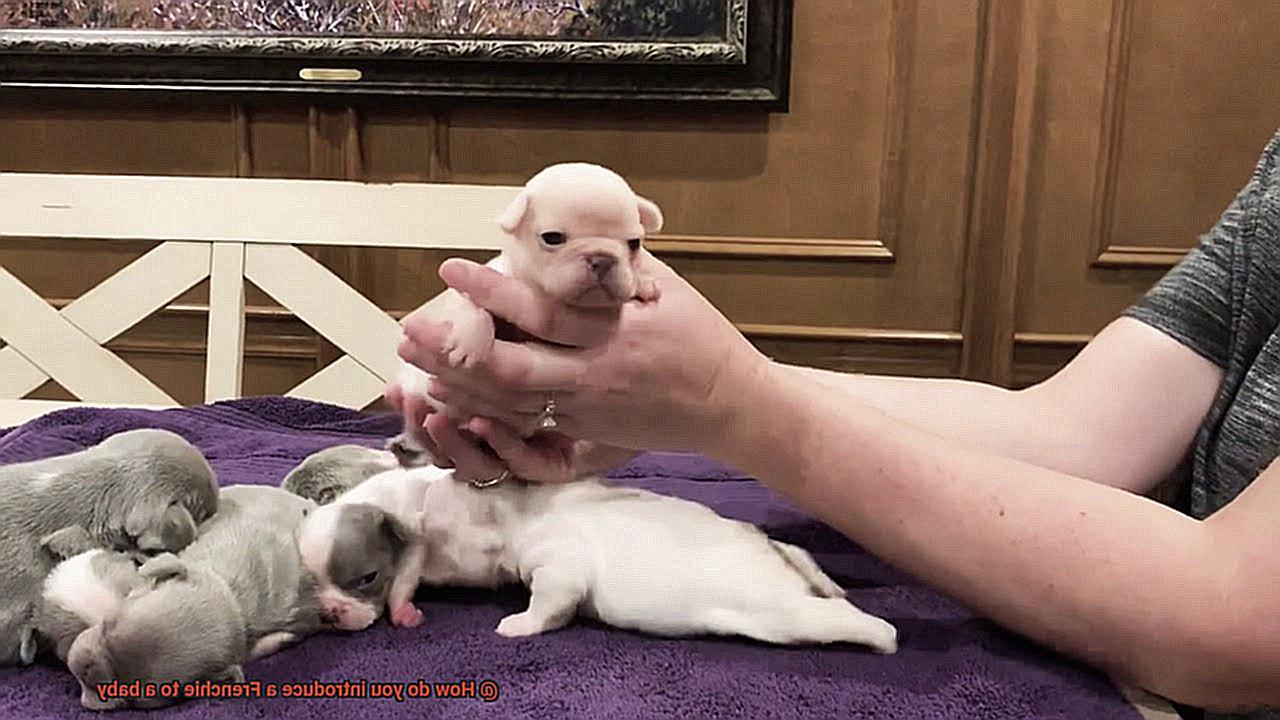
Teach both the Frenchie and the baby what is considered appropriate behavior during their interactions. Train your Frenchie not to snatch food from the baby’s hands or jump up on them. Teach the baby not to pull the dog’s fur or provoke them. This ensures a safe and respectful environment for both.
Provide safe spaces

Create designated safe spaces for both the Frenchie and the baby. Offer a separate area for the Frenchie to retreat to if they feel overwhelmed. Ensure the baby’s crib or play area is off-limits to the dog, maintaining safety for both parties.
Consult a professional

If you’re unsure about how to safely introduce your Frenchie to your baby, seek guidance from a professional like a veterinarian or dog trainer. They can provide personalized advice based on your specific situation and help ensure a smooth and safe introduction process.
How to Respond if Your Frenchie Shows Signs of Stress or Discomfort
Bringing home a new baby is an exciting time for any family, but it’s important to ensure a smooth and safe transition for everyone involved, including your beloved Frenchie.
French Bulldogs are known for their affectionate nature, but proper introductions and gradual acclimation are crucial to establish a positive relationship between your Frenchie and the new baby.
Preparing Your Frenchie:
Before the baby arrives, it’s essential to prepare your Frenchie for the upcoming changes. Start by providing basic obedience training to ensure they understand and respond to commands. This will help establish boundaries and ensure they follow instructions around the baby. Additionally, expose your Frenchie to baby-related sounds, scents, and sights to familiarize them with these stimuli.
The Initial Meeting:
When the baby arrives, create a calm and controlled environment for the initial introduction. Avoid overwhelming your Frenchie with a sudden meeting. Instead, allow them to sniff and explore items with the baby’s scent before making direct contact. Use a baby gate or playpen as a physical barrier during the first interactions, allowing both parties to observe each other without direct contact.
Gradual Interactions:
As your Frenchie becomes more comfortable, gradually introduce supervised interactions between them and the baby. Always ensure that both the Frenchie and the baby are calm and relaxed before proceeding with direct contact. Use a leash initially and reward positive behavior from both sides with treats and praise.
Monitoring Behavior and Safety:
Monitor your Frenchie’s behavior closely during interactions with the baby. Look out for signs of stress or discomfort, such as growling or attempting to avoid the baby. If any negative behaviors arise, address them promptly and consider seeking guidance from a professional dog trainer or behaviorist.
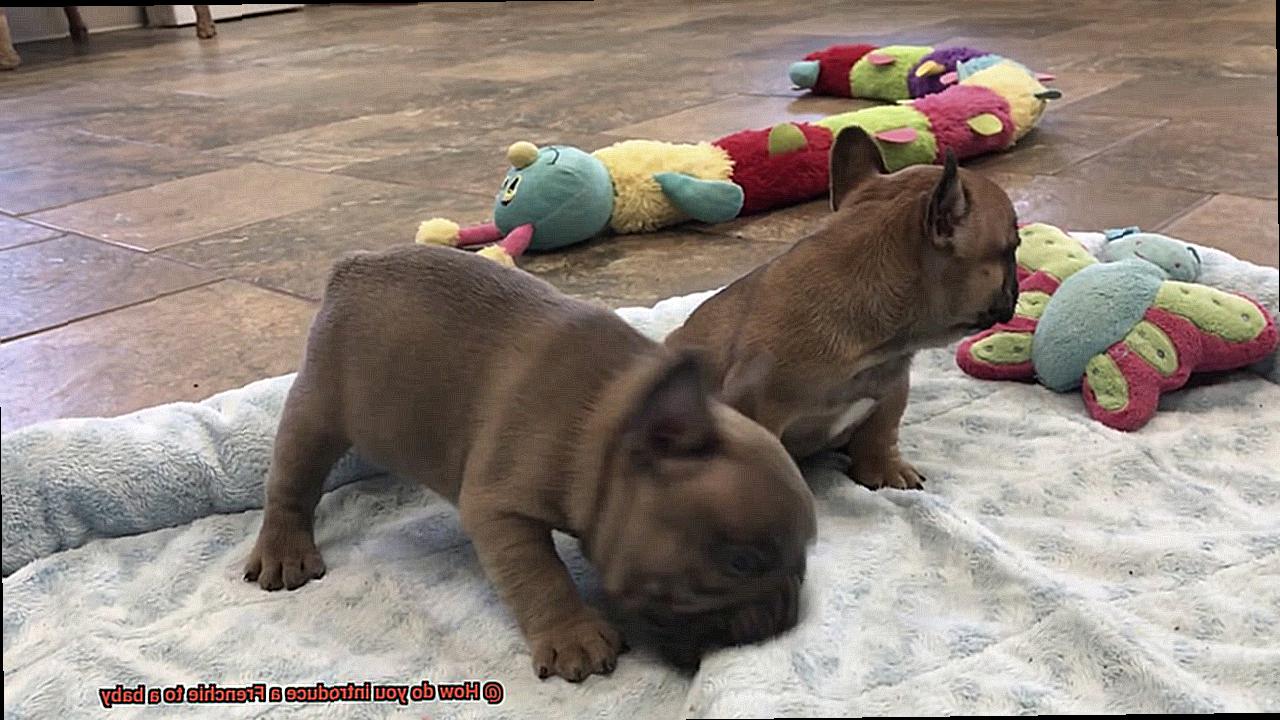
Ongoing Supervision and Safety Measures:
Never leave your Frenchie and the baby unsupervised, especially in the early stages of their relationship. Teach your child how to interact with the Frenchie safely, such as avoiding pulling on their ears or tail. Encourage gentle and respectful behavior from both sides.
Teaching Your Child How to Interact with the Dog
Introducing a Frenchie to your family is like adding a new member to the pack. And just like any new member, it’s important to teach your child how to interact with your furry friend in a safe and positive manner. Here are some woof-tastic tips to help you do just that:
Supawvision is Essential
First and foremost, always have an adult present when your child and Frenchie are together. Accidents can happen in the blink of an eye, so it’s crucial to keep a watchful eye on their interactions.
Gentle Pats and Belly Rubs
Teach your child the art of gentle touch. Show them how to softly pet your Frenchie’s back or give them gentle belly rubs. Remind them to be slow and calm, avoiding any rough or aggressive movements that could startle or harm the pup.
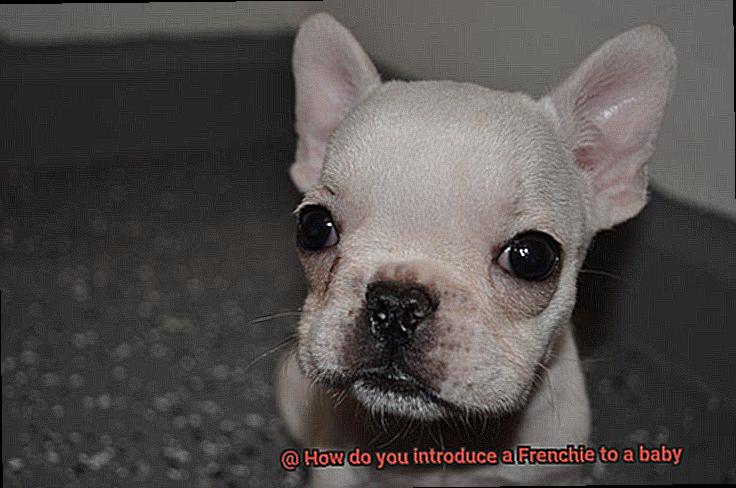
Respect Personal Space
Just like humans, dogs need their personal space too. Help your child understand that not all dogs enjoy being hugged or held tightly. Encourage them to give the Frenchie some breathing room when needed.
No Pulling or Tugging
Paws off those floppy ears and curly tail. Teach your child never to pull on any part of the Frenchie’s body. It can be painful and may cause the dog to react negatively. Instead, show them how to engage in gentle play with appropriate toys.
Playtime Rules
Teach your child the paw-some rules of playtime with your Frenchie. Encourage them to use toys for interactive play and avoid roughhousing or engaging in games that could potentially harm the doggo.
Boundaries for All
It’s impawtant to establish boundaries for both your Frenchie and your child. Teach your child not to disturb the dog while eating or sleeping, and explain why it’s important to give the pup some privacy during these times.
Give Pawsitive Reinforcement
When your child interacts with the Frenchie in a pawsitive way, make sure to give them a high-paw. Praise their gentle behavior and kind gestures towards the dog. This will reinforce good habits and foster a loving relationship between them.
Reading Doggy Language
Teach your child to be fluent in doggy language. Help them recognize signs that indicate your Frenchie may be feeling uncomfortable or scared, such as a tucked tail, flattened ears, or growling. Explain that during these times, it’s impawtant to give the dog space and not approach it.
Cultivating Empathy
Encourage your child to develop empathy towards animals, including your Frenchie. Teach them to be kind, patient, and understanding of the dog’s needs and emotions. This will help create a bond built on love and compassion.
etBz5RY7mco” >
Conclusion
Introducing a Frenchie to a baby is an important and delicate process.
It requires patience, supervision, and careful consideration of both the dog’s and the baby’s needs. When bringing these two together, it is crucial to create a safe and controlled environment.
Start by allowing the Frenchie to sniff and explore the baby’s scent from a distance. Gradually, with close supervision, allow them to interact under controlled circumstances.
Always prioritize safety and ensure that both the Frenchie and the baby are comfortable throughout the introduction.
